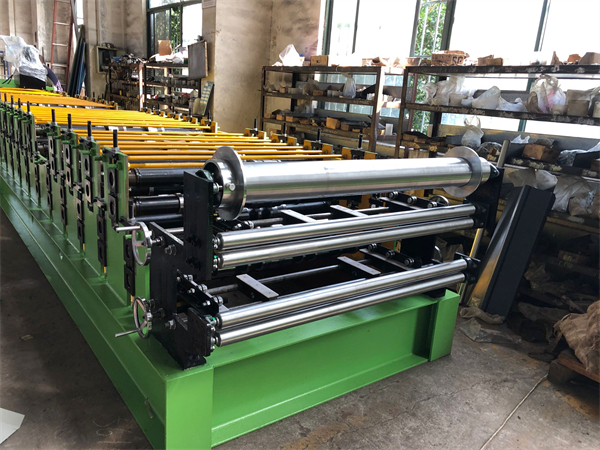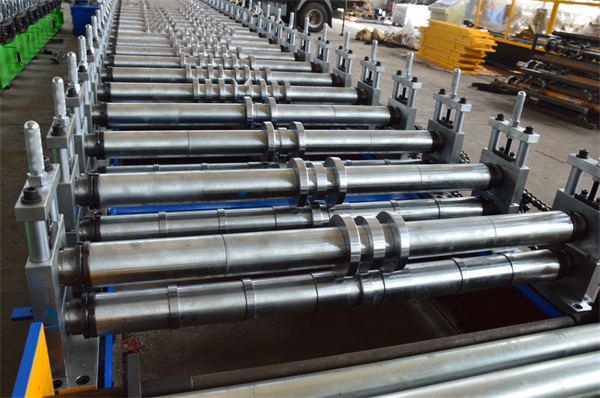Garage doors are an essential part of any home or building. They provide security, insulation, noise reduction, and curb appeal. Traditional garage doors were often heavy, inefficient, and prone to wear and tear. The advent of roll forming technology revolutionized garage door manufacturing, providing lighter, stronger, and more energy-efficient doors. This article will explore everything you need to know about garage door roll forming machines.
Apa yang dimaksud dengan Mesin Roll Forming?
Roll forming is a metal working process that forms metal sheets into customized profiles using a series of consecutive roller dies. The roller dies progressively shape the sheet as it passes through each station of the roll former. This incremental rolling action gradually forms the metal into the desired shape.
Roll formed products have a high degree of accuracy and consistency. The roller dies can form complex profiles that might be difficult or impossible with other fabrication methods. In addition, the roller dies only contact the edges of the sheet metal, not the entire surface. This helps prevent scratches or markings on the surface of the profile.
Benefits of garage door roll forming machines
Using roll formed garage doors offers numerous advantages over traditional doors:
- Lighter weight – Roll formed steel doors weigh up to 50% less than wood or fiberglass doors. The lighter doors make for easier installation and operation.
- Superior strength – The incremental rolling process work-hardens the steel, increasing its strength. Roll formed doors resist dents and damage.
- Efisiensi energi – The tight tolerances of roll formed doors reduce air infiltration. Insulated doors provide thermal efficiency.
- Daya tahan – Roll formed steel resists rot, decay, and insect damage better than wood or fiberglass. The doors enjoy a long service life.
- Pengurangan kebisingan – The rigid steel construction dampens noise transmission better than other materials.
- Estetika – Steel doors accept a wide range of ornamental patterns and finishes for great curb appeal.
For these reasons, roll formed doors now dominate the residential garage door industry.

Parts of a Roll Formed Garage Door
While designs vary, most residential roll formed garage doors consist of three main components:
Panel
The door panels form the main surface area of the door. Most standard residential doors contain four to six panels. The most common panel style features distinctive horizontal grooves across the length of the panel. Other popular options include short raised panels, long raised panels, flush panels, and wood grain textures.
Insulation can be sandwiched between an inner and outer metal skin to improve the door’s thermal efficiency. Polyurethane foam provides optimal insulation properties.
Hinges and Brackets
Hinges connect the panels together, allowing the door to articulate. Standard residential doors use heavy duty galvanized steel hinges. Commercial and industrial doors may incorporate aircraft quality hinges for extra durability.
Mounting brackets attach the hinged door panels to the track system along the sides of the doorway. The brackets are typically made from galvanized steel or other corrosion resistant materials.
Trek
Tracks guide the door up and down along the doorway’s jambs. Most residential doors use vertical tracks with a short horizontal section for the top panel to rest on when open. Commercial and industrial doors often feature full horizontal tracks along the ceiling for additional clearance. The tracks are formed from galvanized steel for corrosion resistance. High quality nylon or steel rollers inside the brackets glide smoothly along the track.
The Roll Forming Process
Constructing a roll formed garage door involves gradually transforming flat metal coils into shaped door components through multiple rolling stages:
1. Uncoiling
Coiled steel sheet gets mounted onto a de-coiler which unrolls and straightens the steel prior to forming. This unwinds the coil and feeds a straight sheet into the roll former.
2. Pra-pembentukan
Optional pre-forming rollers make initial light indentations along the sheet to facilitate the subsequent rolling phases.
3. Pembentukan
The heart of the process – the sheet passes through consecutive forming rollers which incrementally bend, shape, and crimp it into the final profile. The rollers only contact the sheet along its edges, not the face.
4. Cutting
A rotating saw blade or hydraulic shear cuts the formed sheet into appropriately sized sections as it emerges from the final forming rollers.
5. Hardware Attachment
Hinges, brackets, insulation, and other hardware fixtures get affixed to the cut door sections.
The roll formed components then go to final assembly, packaging, and shipping.
Konfigurasi Mesin Roll Forming
The modular nature of these machines allows for many possible configurations:
- In-line – The decoiler, pre-forming, forming, and cutting stations align end-to-end for efficient high volume production.
- Ringkas – For space constrained shops, the stations can stack vertically with the sheet making 90 degree turns between stations.
- Powered – Powered machines utilize motors and gears to continuously pull the sheet through each station.
- Manual – Manual machines rely on hand cranks or chains to advance the sheet. Manual operations suit low volume production.
- Number of heads – More heads allow for more complex profiles and increased throughput. 12-16 heads are typical for garage doors.
- Customizable tooling – Roll former tooling is customizable with different roller dies to produce specialized door profiles.
No matter the layout, all roll formers work on the same fundamental principle of progressive incremental rolling.
Spesifikasi Umum
While specs depend on the machine model and manufacturer, most roll forming lines for garage doors fall into the following ranges:
- Sheet width capacity – 50 to 100 inches
- Sheet thickness capacity – 28 to 22 gauge
- Roll stations – 10 to 20
- Forming speed – 15 to 40 feet per minute
- Motor power – 3 kW to 7.5 kW
- Decoiler capacity – 5,000 to 20,000 pounds
Major Components of a Roll Forming Machine
Roll formers contain a number of key components engineered to work together:
- Decoiler – This unwinds the coiled sheet and feeds it into the first stations. It contains adjustments for sheet width and tension.
- Meja pakan – Supports and guides the sheet into the initial forming rollers. Often includes pre-forming indent rollers.
- Membentuk kepala – The consecutive rolling heads that progressively shape the sheet. Constructed from machined steel, iron, or a combination.
- Rol – Hardened steel rollers within the forming heads that contact and bend the sheet. Different profiles require unique roller shapes.
- Forming motors – Provide power to turn the rolling heads and pull the sheet through the machine.
- Stasiun pemotongan – Saws or hydraulic shears that cut the formed sheet into properly sized sections.
- Kontrol – Operators control the speed, feed, and cutting from a master control panel.
- Panduan – Rollers and channels that support the sheet throughout the forming and transport process.
- Bingkai – A rigid steel frame houses the components and maintains precise alignment.

How to Choose a Garage Door Roll Former
Selecting the right roll forming machine for your garage door production needs involves considering these factors:
- Volume – Estimate your projected monthly or annual door output to determine ideal machine capacity.
- Sheet requirement – Consider what width coils and gauge thickness you plan to run. Confirm the machine matches these.
- Daya – Manual, powered, or a combination. Assess if motorized stations will benefit your operations.
- Otomatisasi – Determine if you need automatic versus manual cutting for efficiency.
- Door styles – Identify which door profiles you aim to produce and select compatible tooling.
- Space efficiency – Evaluate if an in-line or vertical configuration better fits your shop layout.
- Anggaran – Weigh capital investment against projected ROI and production needs.
- Perluasan – See if the machine allows for future additions of rolling heads or stations.
- Kualitas – Opt for a well-engineered machine built to tight tolerances for consistency.
Once you determine these factors, you can zero in on the ideal garage door roll former that aligns with your manufacturing objectives and business goals.
Leading Garage Door Roll Former Manufacturers
Some of the top global suppliers of roll forming equipment for garage doors include:
- Baileigh Industrial – Offers powered and manual roll formers in various configurations. American based company.
- Metform – Renowned manufacturer of high end automated roll forming lines. Based in New Zealand.
- Jupiter Enterprise – Indian company specializing in powered and manual roll formers. Competitively priced.
- Uzmintsystems – Turkish fabricator of roll formers for garage doors and architectural metals.
- CO-MAT – One of Asia’s leading roll forming machine companies. Based in Taiwan.
- Eagleweld – Budget oriented manufacturer of entry level garage door roll forming equipment. Based in China.
Carefully vet any company to confirm they engineer rigid and precise machines that produce dimensionally accurate components.
Operating a Roll Forming Line Safely
While efficient and productive, roll forming equipment contains many moving parts requiring caution:
- Keep body parts, clothing, jewelry, and long hair away from the rolling dies when running.
- Ensure safety guards are in place prior to operation.
- Wear proper PPE such as close-fitting clothing, gloves, and eye protection.
- Grip strips emerging from the cutter to avoid recoil that could cause injury.
- Make sure electrical panels, covers, and cords are in good repair before use.
- Confirm proper grounding prior to operation.
- Turn off and unplug machine when adjusting tooling or performing maintenance.
- Keep work area clean and free of clutter to avoid slips or falls.
With training and safe working practices, roll formers provide an extremely useful fabrication method for producing residential and commercial garage doors.

Kesimpulan
In closing, garage door roll forming machines provide an extremely efficient method of producing high quality steel doors. Their incremental rolling process forms doors with excellent strength, durability, and energy efficiency. Understanding how these fabricating lines work and selecting the right configuration for your needs will ensure successful door manufacturing. With appropriate operation and safety practices, roll formers can churn out doors to meet both residential and commercial demands.
FAQ
Roll forming garage doors efficiently revolutionized the industry. But you may still have some questions about these versatile machines. Here are answers to some frequently asked questions:
What thickness of steel can be roll formed?
Most residential garage door roll formers accommodate metal gauges from 18 gauge to 28 gauge. This covers the common 0.040 to 0.016 inch thickness range used for doors. Machines able to handle thicker materials can form down to 16 gauge steel.
Can you roll form aluminum?
Yes, aluminum coils can go through a roll forming line. However, aluminum requires specialized tooling and modifications to the machine. The ductile metal deforms differently than steel when rolled. Output speed with aluminum tends to be slower.
What other products can these machines make?
While optimized for garage doors, roll formers produce a wide variety of architectural building components. Other applications include roofing panels, siding, framing studs, solar racking, floor joists, and rainware gutters.
Is roll forming cost effective?
The automated nature of roll forming results in very economical production costs compared to labor intensive manual fabrication methods. And metal coil raw material is relatively inexpensive. For high volume door production, roll forming provides excellent value.
How long does it take to form each door?
The total forming time depends on the machine speed, length of the profile, and number of stations. Typical powered roll formers produce a finished door in 1 to 3 minutes. With multiple heads and optimal steel gauge, doors can form in under a minute.
Can I make custom profiles?
One of the biggest advantages of roll forming is the ability to create specialized profiles by changing the roller dies. Most manufacturers offer modular tooling that can produce unique shaped doors to order.
Perawatan apa yang diperlukan?
Roll forming lines require regular lubrication of bearings and guides. The forming rollers eventually wear over time from contact with the metal. Routine inspections identify rollers that need replacement. Keeping the machines clean maximizes uptime.
